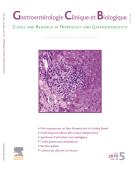Liver abscess after radiofrequency ablation of tumors in patients with a biliary tract procedure - 26/03/08
Dominique Elias [1],
Daniela Di Pietroantonio [1],
Bertrand Gachot [2],
Paola Menegon [1],
Antoine Hakime [3],
Thierry De Baere [3]
Mostrare le affiliazioniAbcès hépatiques au décours d'une destruction tumorale par radiofréquence chez des malades porteurs d'une dérivation biliaire |
Objectifs |
L'incidence des abcès hépatique après destruction par radiofréquence (RF) de tumeurs hépatiques semble élevée chez les patients porteurs dune dérivation bilio-digestive. Cependant à ce jour, ni l'incidence ni le délai de ces abcès en fonction du statut biliaire n'ont été rapportés dans la littérature.
Méthodes |
Parmi 574 malades traités par RF sur 8 ans, seuls 11 malades (13 sessions de RF, 2 malades ayant eu deux sessions) présentaient une anastomose bilio-digestive ou une prothèse biliaire, au moment de la RF. Il s'agit d'une étude rétrospective de données enregistrées de manière prospective.
Résultats |
Sur les 9 malades qui étaient porteurs d'une dérivation bilio-digestive antérieure à la destruction par RF, 4 ont développé un abcès sur le site du traitement, diagnostiqué entre 13 et 62 jours. Ces abcès sont survenus malgré l'utilisation de plusieurs types de courtes antibio-prophylaxies. Les bactéries pathogènes étaient toujours de type digestif. Les abcès ont été traités avec succès par drainage percutané. Aucun abcès n'est survenu chez les 4 patients qui ont eu une dérivation bilio-digestive synchrone à la RF.
Conclusion |
Quand une destruction par RF est réalisée chez un malade porteur au préalable d'une dérivation bilio-digestive, le risque d'abcès hépatique est élevé. Actuellement nous ne pouvons pas recommander un type particulier d'antibio-prophylaxie. Une dérivation biliaire préexistante n'est pas une contre indication absolue à un traitement par RF, mais le risque d'abcès est compris entre 40 et 50 % dans ce cas. Par contre, quand la RF est réalisée au même moment que la dérivation biliaire, le risque d'abcès semble très faible.
Aim |
The rate of liver abscesses after radiofrequency ablation (RFA) of liver tumors is probably high in patients with a biliary tract drainage procedure connecting the biliary duct system to the upper gastrointestinal tract. And yet, to date this rate, the time of onset of these abscesses, and the prior status of the bile ducts have never been reported in the literature.
Methods |
Among 574 patients treated with RFA over 8 years, only 11 patients (with 13 sessions of RFA, 2 patients undergoing two different RFA sessions) presented with an enterobiliary anastomosis or biliary stenting at the time of RFA. This is a retrospective study of patients who were verified prospectively.
Results |
Among the 9 patients in whom a biliary tract procedure preceded RFA, 4 developed a liver abscess at the site of RFA, which emerged between 13 and 62 days after RFA. It occurred in spite of different types of short-term antibiotic prophylaxis. Pathogenic bacteria were typical of the digestive flora. Abscesses were cured after percutaneous drainage. No abscess occurred among the 4 patients in whom a biliary tract diversion was performed synchronously with RFA.
Conclusion |
When RFA is performed in a patient with a preexisting biliary diversion, the risk of developing a liver abscess is high. Currently, we are unable to recommend any kind of preventive antibiotherapy. A preexisting biliary diversion is not an absolute contraindication for RFA, but the risk of developing a liver abscess is close to 40-50%. When RFA is performed synchronously with a biliary diversion, the risk of a liver abscess seems to disappear.
Mappa
© 2006 Elsevier Masson SAS. Tous droits réservés.
Vol 30 - N° 6-7
P. 823-827 - Giugno 2006 Ritorno al numeroBenvenuto su EM|consulte, il riferimento dei professionisti della salute.

